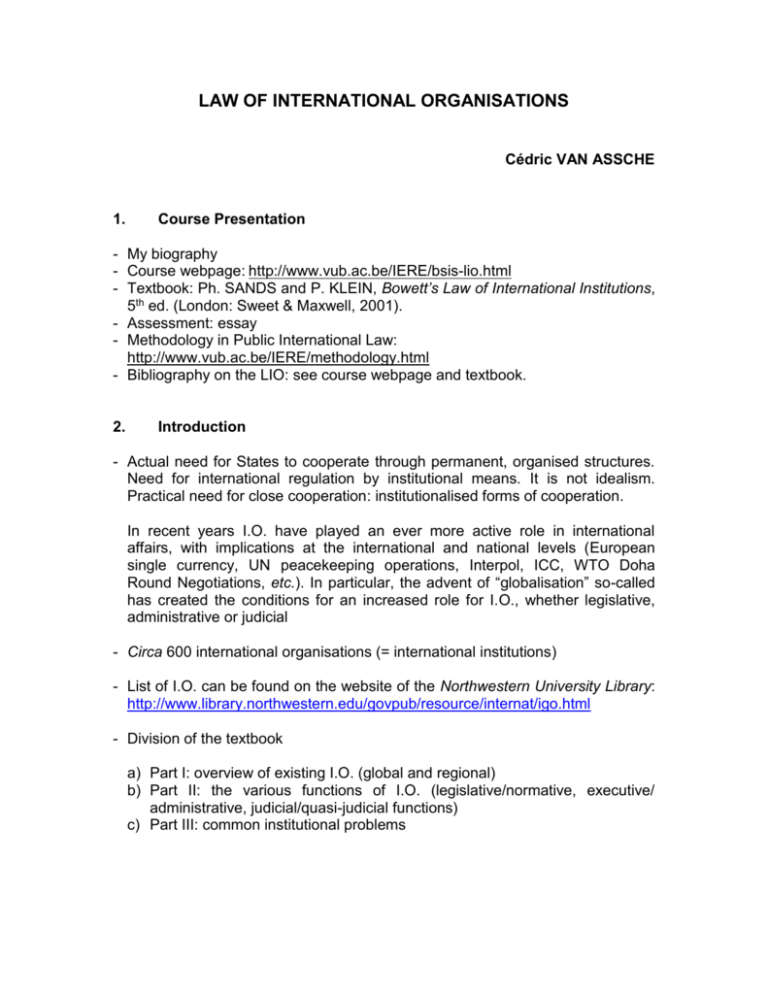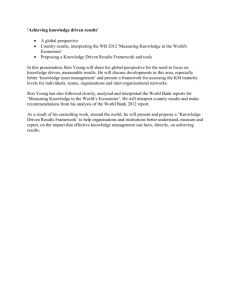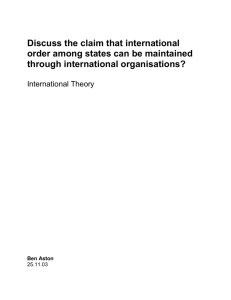LAW OF INTERNATIONAL ORGANISATIONS
advertisement

LAW OF INTERNATIONAL ORGANISATIONS Cédric VAN ASSCHE 1. Course Presentation - My biography - Course webpage: http://www.vub.ac.be/IERE/bsis-lio.html - Textbook: Ph. SANDS and P. KLEIN, Bowett’s Law of International Institutions, 5th ed. (London: Sweet & Maxwell, 2001). - Assessment: essay - Methodology in Public International Law: http://www.vub.ac.be/IERE/methodology.html - Bibliography on the LIO: see course webpage and textbook. 2. Introduction - Actual need for States to cooperate through permanent, organised structures. Need for international regulation by institutional means. It is not idealism. Practical need for close cooperation: institutionalised forms of cooperation. In recent years I.O. have played an ever more active role in international affairs, with implications at the international and national levels (European single currency, UN peacekeeping operations, Interpol, ICC, WTO Doha Round Negotiations, etc.). In particular, the advent of “globalisation” so-called has created the conditions for an increased role for I.O., whether legislative, administrative or judicial - Circa 600 international organisations (= international institutions) - List of I.O. can be found on the website of the Northwestern University Library: http://www.library.northwestern.edu/govpub/resource/internat/igo.html - Division of the textbook a) Part I: overview of existing I.O. (global and regional) b) Part II: the various functions of I.O. (legislative/normative, executive/ administrative, judicial/quasi-judicial functions) c) Part III: common institutional problems 2 3. Definition - Three categories on international organisations: a) intergovernmental organisations b) international non-governmental organisations (NGOs) c) inter-state enterprises (établissements public internationaux) European School) (e.g. - To qualify an entity as an international intergovernmental organisation, it must have the following characteristics: a) its membership must be composed of States and/or other I.O.; b) is must be established by treaty; c) it must have an autonomous will distinct from that of its members and be vested with legal personality; and d) it must be capable of adopting norms addressed to its members. - Law of I.O. stricto sensu = law of intergovernmental organisations - Recent practice of COPs (which are not expressly endowed with international legal personality): sui generis autonomous institutional arrangement between diplomatic conferences and I.O. 4. LIO is branch of Public International Law - Each I.O. has its own governing law deriving from: a) its constituent instrument; b) the decisions and resolutions it adopts in conformity with its constituent instrument; c) its established practice. - LIO = common law of international organisations (e.g. the principle of speciality of the (explicit and implied) powers of I.O.) 5. Classification of I.O. - Classification of I.O. for purposes of presentation and description. No scientific classification. - Distinction between administrative or technical organisations (cf. public international unions and UN specialised agencies), political organisations (League of Nations, UN) and judicial organisations (ICC, ITLOS) 3 - Distinction between I.O. of comprehensive or general competence and I.O. of limited competence - Distinction between I.O. of a global membership and I.O. of a regional membership - Distinction between I.O. with supranational powers (power to bind Member States by their decisions taken by (qualified) majority) and I.O. without supranational powers 6. Historic Survey - Bilateral diplomacy: Bilateral consular and diplomatic relations: from ad hoc to permanent bilateral diplomacy - Multilateral diplomacy: a) international diplomatic conferences1. Four disadvantages: (1) ad hoc character; (2) rigidity of the debates; (3) invitation by sponsoring/host State – no principle of membership conferring automatic right to representation or participation; and (4) unanimity rule (voting) b) public international unions2 (international administrative unions or international bureaux) preceded by private international unions3. Problem of coordination of activities of public international unions. c) League of Nations (1919-1946) Objectives: (1) promote international cooperation; (2) achieve international peace and security 1 E.g. Conference of Westphalia (1648), Congress of Vienna (1815), Berlin Conferences (1884 and 1885), The Hague Conferences (1899 and 1907), Paris Conferences (1919), etc. 2 In the field of communications: Rhine Commission (1815), Elbe Commission (1821), Douro Commission (1835), Po Commission (1849), European Commission on the Danube (1856), Pruth Commission (1866), International Union of Railway Freight Transportation (1890), International Telegraphic Union (1865), Radiotelegraphic Union (1906), Universal Postal Union (1874). In the field of health: International Office of Public Health (1907). In the economic field: Metric Union (1875), International Copyright Union (1886), International Sugar Union (1902), International Institute of Agriculture. 3 E.g. International Committee of the Red Cross (1863), International Law Association (1873), Institut de droit international (1873), International Literary and Artistic Association (1878), International Ornithological Committee (1884), Inter-Parliamentary Union (1889), International Dental Federation (1900), Union of International Associations (1910), International Chamber of Commerce (1919), etc. 4 System of collective security based on: + disarmament (Art. 8 of Covenant) + pacific settlement of disputes: peace disruptive disputes to be submitted to arbitration, judicial settlement or to inquiry by the Council of the League (Art. 11-15 of Covenant) + limitation on war by 3 months cooling-off period (Art. 12(1) of Covenant) + prohibition on war if arbitral award, judicial decision or unanimous Council report executed (Art. 13(4) & 15(6) of Covenant)4 + collective guarantee of independence of each member against external aggression (Art. 10) + sanctions (Art. 16-17) Organs: Council, Assembly and Secretariat ( Permanent Court of International Justice, separate institution) Failure to prevent the outbreak of Second World War =) dissolution of the League on April 18, 1946 d) UN + specialised agencies -------------------------- 4 The outlawing of war by the 1928 Kellogg-Briand Pact (Pact of Paris): General Treaty for the Renunciation of War (jus contra bellum). Exception: Self-defence.






